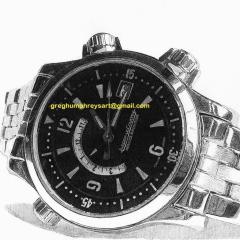-
Recently Browsing
- No registered users viewing this page.
-
Topics
-
Posts
-
To be honest, they're not a good movement to have in a chronograph for several reasons. The first is the chronograph mechanism is a 'bolt on' module; If you look at the side of the watch case the crown won't be in line with the pushers, therefore only the branded company would have the ability to swap out the module because they aren't designed to be serviced and definitely not by an independent watchmaker. Secondly, the ETA 2892 A2 is a great movement, but when the chrono module is used with it it becomes pants, in my opinion/experience. So, going back to your watch. The problem isn't with the base movement, which is the 2892A2, as there would never be that amount of backlash/flutter in the gear train of that particular movement, it is with the chrono bolt on module that the problem lies and when the chrono sweep second hand is engaged the flutter of the second hand is remedied by the stability of the chronograph mechanism negating that flutter. Everything in the chronograph mechanism of that movement is powered by a wheel in the centre where the cannon pinion/driving wheel would normally be. I think it is a crappy design deliberately engineered to be disposable due to the time taken to service the module. Give me a 7750 any day!
-
By Neverenoughwatches · Posted
Yeah not much going on in the town , Scarborough is a bit better,but the missus and me love York. Good antique shops there, The antiques center on stonegate has a good selection of vintage watches, top price though. -
Thank you for your introduction and welcome to this friendly forum. We all look forward to your contributions and continued involvement.
-
Brid isn't what it used to be, I only really go to Morrisons in brid. I avoid the town. But Scarborough is nice! I don't mind a wander round the beach between jobs
-
I have had a few issues with my Orient Automatic crystal and bezel. The bezel came off with a case knife and I haven't been able to refit it. Doing a bit of research on here, I think that it is an arrangement where the crystal is snapped over a lip on the caseback and then the bezel is installed over the top like a tension ring. I have managed to crack the crystal trying various attempts to press it onto the case. Measuring the crystal with Vernier calipers, I think it is a Sternkreuz XS 314.171 but I can't correspond that to the reference/ case number on the caseback. I also measured the outer diameter of the lip on the case that it may fit over and this is 30.5mm, which is actually 0.7mm bigger than the static inner diameter. Is it likely that the crystal can be expanded enough to snap over that? The inner diameter of the bezel/ tension ring is 32.2mm which works with 31.4+0.7 = 32.1mm Does this sound correct? What method should I use to snap the crystal and then bezel into place? I have a cheap case back press with nylon dies but I managed to break the old one with this method.
-









Recommended Posts